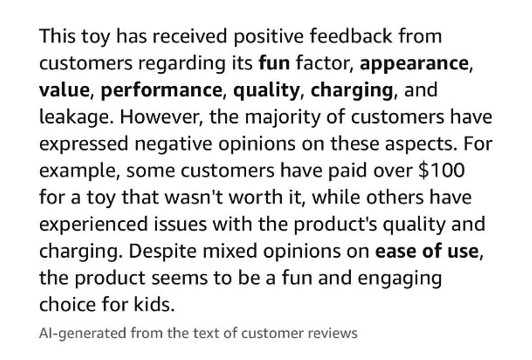Summary
The article explores the transformative potential of Generative AI in the retail sector, drawing a parallel to the holographic librarian Vox 114 from the movie “The Time Machine.”
- AI solutions like Chat GPT, Microsoft’s Copilot, and investments from Google and Salesforce are reshaping work processes, with an estimated $4.4 trillion economic value attributed to Generative AI by McKinsey.
- Generative AI has the capacity to amplify the customer voice in retail, addressing challenges in managing and utilizing extensive customer feedback data.
- The technology rapidly comprehends and summarizes customer sentiment from sources such as product reviews, social media, and call logs, as demonstrated by Amazon’s use for customer assistance.
- Retailers can leverage Generative AI to internally share summarized feedback, aiding decision-making and strategy development.
- Caution is advised due to potential bias and inaccuracies in AI models, emphasizing the need for specialized training data.
- By interpreting, categorizing, and distributing customer feedback, Generative AI democratizes information across organizations, fostering better decision-making and customer satisfaction.
How Generative AI Will Raise the Voice of the Customer
By Navjit Bhasin, Founder & CEO of Newmine
In a 2002 film, The Time Machine, loosely based on the H.G. Wells novel, Guy Pearce’s character, Dr. Alexander Hartdegen, time travels to 2037, where he interacts with a holographic librarian called Vox 114, played by Orlando Jones. This AI-generated hologram is a compendium of all human knowledge, allowing the protagonist to retrieve any information he wants through natural human language. It’s an amazing technology but not transformative; it makes accessing knowledge more efficient. The holographic librarian is a better user interface.
Later in the film, Dr. Hartdegen travels 800,000 years into the future and finds that human civilization has reverted to a primitive form. Surprisingly, Vox 114 is still active, has learned from his surroundings, and remembers everything. But in this setting, he is transformative when he becomes a teacher for the children, unlocking their potential and passing knowledge to them in the most natural of forms, storytelling.
While AI solutions have been around for years, the emergence of Chat GPT has elevated the specter of AI. Microsoft’s Copilot and other investments by Google and Salesforce promise to transform how work is done. McKinsey estimated that Generative AI could add $4.4 trillion of economic value and automate work activities that absorb 60 to 70 percent of employees’ time today.
While the focus has been primarily on productivity or generating images, generative AI and language models can elevate the customer voice within the retailer and give both retailers and brands something that their customers always thought they were doing – listening to their feedback and making changes.
Despite retailers’ best intentions, most customer feedback at mid and large-sized organizations is ignored. And the information that isn’t ignored is rarely acted on. The problem is volume and access. While numerous methods exist to gather customer sentiment through product reviews, call logs, feedback forms, and social media, collecting, analyzing, and offering that information to the right people at the right time is labor-intensive. As a result, it isn’t done except for a small portion of a retailer’s assortment. Generative AI can change that.
AI and natural language models quickly read, comprehend, and summarize customer feedback from product reviews, social media, call logs, and other sources in a fraction of the time that people can do it. Amazon is already experimenting with generative AI for a similar purpose. They use the technology to summarize product reviews to assist customers in purchasing. An example of this is below.

While Amazon uses generative AI for assisted selling, that same type of summarized information can be shared internally with the appropriate retail teams. As highlighted in the example, if customers are experiencing issues with the quality, specifically the charging, there’s a product defect from a poor design. If paying $100 for a toy that “isn’t worth it,” perhaps the merchandise should be discounted or liquidated. Additionally, with this information, a retailer can recoup money from the vendor while providing incredible feedback to the vendor for future product improvements.
Despite the wonders of Generative AI, it has come with warnings – namely, bias and inaccuracies. In this context, errors and bias in actioning customer feedback are unacceptable. Hence, the data you train your models must be retail, vertical, country, and company-specific based on private data. Beyond just outright errors, there are practical reasons for this. Take the word “pants.” In the US, “pants” refers to jeans, trousers, or outerwear. But in the UK, “pants” can mean underwear. Confusing this terminology could result in new, unintended memes for the retailer.
Interpreting customer feedback is one side of the coin. The other side is accessing and presenting the information to people in a form they can understand and act on. Some of these questions could include:
- How can I improve the customer shopping experience for my mall-based stores?
- What do customers like about our footwear? What would they want to see changed?
- We used a new sustainable fabric. What are our customers’ reactions to the product? Are they keeping the product more? What are the cost/benefit trade-offs?
- Why are customers keeping my Fashionista dress but returning my FashionNuuvu dress?
The answers to these questions are driven by customer feedback and actions. Traditionally, customer data might be sitting in a CRM system, and there was limited ability for someone from merchandising or sourcing to access it without a report. Hence, it would be buried within the bowels of a retailer’s organization.
So how is this different than Vox 114, or the hologram librarian, at the beginning? All it’s doing is categorizing information and making it easier to access. Well, no. Vox 114 was the next evolution of a user interface. Before Vox 114, humans could always access the library and get information. Vox 114 just made it faster. Public libraries and classification systems like the Dewey Decimal System were more revolutionary leaps because many library stacks were closed to all except privileged patrons before those events.
The combination of interpreting, categorizing, and sharing the customer voice across retailers and brands will unlock additional financial and customer benefits since most retailers can only do this today with AI. Information will become democratized across an organization allowing people across the organization and at all levels to use the information to make better decisions. And the customer will see their feedback rewarded with better products and experiences. It’s a positive feedback loop connecting the customer’s voice with all aspects of retailers’ and brands’ business.
